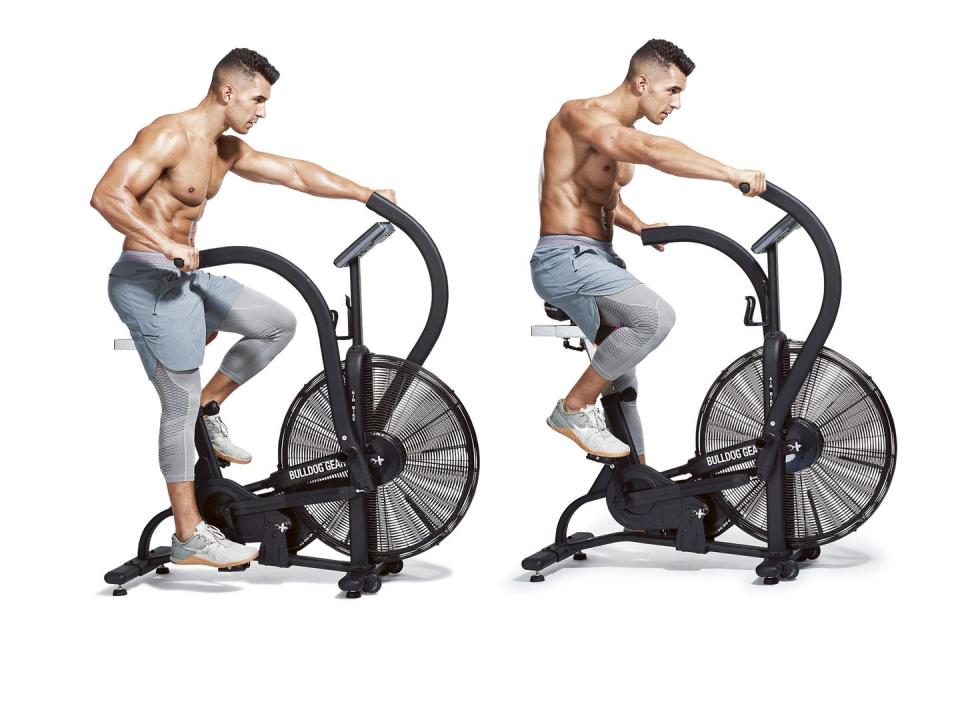Nasal Breathing: Could Breathing via Our Noses, Rather than Mouths, Lead to Gains Across the Board?

Take a moment to consider how you’re breathing? Deep or shallow? Through your nose or mouth? We breathe 25,000 times per day, rarely paying attention to this essential, autonomous bodily function, yet a growing mountain of research suggests we ought to.
Chronic disordered breathing – which is likely linked to today’s sleep-deprived, anxiety-riddled existence – has been linked to an elevated risk of asthma, sinusitis, snoring, allergies, even panic attacks and diabetes.
Depressingly it’s even inspired a new field of research called ‘e-mail apnea’ – a tendency to hold your breath while getting e-bollocked by your boss.
Nasal breathing, it’s claimed, can help control heart rate and blood pressure, manage stress levels and reduce inflammation. So could it be the marginal gain you’ve been missing?
What is Nasal Breathing?
I used to think of nasal breathing like I do ice baths and ayahuasca. I’d heard good things, but never felt inclined to join the party. Sure, I’d dabbled during the odd workout. But the slow creep of asphyxiation that accompanied breathing exclusively via my nostrils was always a bit of a turn off.
And yet its performance enhancing powers have become increasingly hard to ignore, ever since journalist and author James Nestor breathed fresh life into the ancient subject with his seminal work, Breath in 2020.
Pointing to a vast body of peer-reviewed papers, personal experimentation, and a school of Himalayan monks who could raise their body temperature by 17 degrees, Nestor argued that we should all simply close our mouths and breathe. ‘This is magical, voodoo stuff,’ he exclaimed on an episode of Chris Williamson’s Modern Wisdom podcast in 2021.
Now we have Wim Hof teaching celebrities the Breath of Fire on the BBC. We have Erling Haaland extolling the virtues of nostril breathing on Logan Paul’s podcast. And we have four-time Grand Slam champ Iga Świątek – mouth taped – slapping backhand returns on the ATP Tour.
The cat is very much out of the bag when it comes to nasal breathing, but what does the science say?
What Does The Science Say About Nasal Breathing?
Nasal breathing while exercising, its advocates would say, retrains your respiratory system to better tolerate carbon dioxide. You see, ‘air hunger’ as MH Fitness Director and certified performance breathing coach Andrew Tracey neatly puts it, occurs in the presence of rising CO2. ‘The entire autonomous process of breathing is signalled and mediated by the presence of carbon dioxide, not by a lack of oxygen,’ he says.
The feeling of breathlessness and panic that rises as your workout intensifies is your body’s natural response to what it considers an imbalance in blood gases. The involuntary ‘gasp response’ that follows is ‘your body’s attempt to redress this balance,’ Tracey adds.
Suppress this impulse and keep nasal breathing and you’ll spark a chain reaction known as the Bohr effect: levels of CO2 in your bloodstream will build, blood pH will drop; haemoglobin, the main carrier of oxygen, will release O2 more readily; and as a result, oxygen delivery to your working muscles will go through the roof.
Studies suggest nasal breathing during exercise can also reduce ventilation (meaning you needn’t suck in as much air) and generate nitric oxide, a potent bronchodilator and vasodilator, causing blood vessels and airways to dilate, enhancing oxygen uptake.
There are, however, times when nose breathing just can’t cut it. A 2017 study in the International Journal of Kinesiology and Sports Science found that while nasal breathing was more efficient than oral breathing during the 65% and 80% VO2 max efforts, this efficiency rapidly fell away at higher intensities.
We Put It to the Test
So, where to start? Tracey suggests with baby steps, and arms me with a 20-minute guided run set to a 170 bpm metronome.
Easing into my usual 5K route, I’m told to sync my cadence to the tick, tick, tick of the beat, inhaling for four steps, exhaling for four. But within just three minutes, nose streaming, airways constricting, I feel the walls closing in. I’m told to throttle back my pace, to allow a mouth exhale to recalibrate my breathing, yet the panic is too great and I cave, sipping a hungry gulp of air to balance me out.
Undeterred, over the next 10 minutes things begin to click into gear. I’m able to maintain the four seconds in, four seconds out rhythm, and notice my heart rate hovering between 118-133 bpm, well below my zone 2 threshold. Granted, I’m moving at a relative snail’s pace (around a 6-6:30 min/km when I usually cover it two minutes per km quicker) but I’m still moving, and feel like I could keep moving indefinitely.

It’s a very different story in the gym. This time Tracey suggests I kick off with a ‘BOLT Test’ to determine my CO2 tolerance. This involves breathing normally, exhaling fully, then timing how long you can last before needing to come up for air. I score just 20 seconds.
Next he instructs me to tackle an ‘Airbike Wattage Ramp Test’. Here the challenge is to set off at a leisurely 100 watt pace, adding 50 watts as each minute ticks by. Tracey urges me to note when I need to up my breathing rate, resort to oral exhalation, and ultimately, tap out.
In my first attempt, using mouth breathing by way of comparison, I check out at 300 watts (five minutes). In my second, relying solely on nasal breathing, I cave quicker at 250 watts (four minutes). My final test is a nasal breathing reenactment of the CrossFit Open workout 24.1, replete with dumbbell snatches and burpees. Here, I fall totally, utterly apart after just one minute and 10 seconds.
The Men's Health Verdict
I fell back on the technique more than a few times while writing this article. During the rowing leg of a particularly challenging CrossFit workout, I used nasal breathing in a bid to lower my spiking pulse rate. And it felt like it sort of helped. At least, I completed the workout and my heart and lungs didn’t exit my chest á la John Hurt’s Kane in Alien, like I thought they might.
I also fully intend to use Tracey’s guided runs to build my CO2 tolerance, given that was one area where I could see genuine progress. During the earlier 5K run, the narrator spoke about being conscious of any ‘story in your head’ when you start to feel breathless.
‘Remember: you’re breathing,’ he said. ‘Acknowledge the story, don’t ignore it, then let it disappear.’ And this tactic helped me stay calm, reminded me of the power the mind truly has over the body, and, quite possibly, allowed for all the ‘magical, voodoo stuff’ Nestor first wrote about to take hold in my respiratory system.
Nasal breathing, for me, has a time and a place. Deep in the pain cave of a metcon workout: not so much. On a long, slow and steady morning run: why not give it a go?
How To Use Nasal Breathing in Your Own Training
Ready to integrate breath control techniques into your own training regime? Here are the techniques, tests, and workouts you need.
Begin with these tips from former rugby league pro Anthony Mullally, now a breathwork coach at fitness app WithU
Breathe Slow
‘Slower breaths signal to the brain that you’re safe,’ says the ex-Ireland international, who first used nasal breathing to manage nerves on game day. ‘This reduces the physical symptoms of anxiety, helping lower energy expenditure.’
Allow For Adaptation
‘Nasal breathing will naturally cause CO2 to accumulate, which will generate strong sensations of air hunger and panic,’ warns Mullally. Therefore, adaptation is necessary. ‘Be patient. Start with low intensities for short periods as you build up your tolerance.’
Concious Rest
‘Rest time is as important as active exertion,’ says Mullally, advising nasal breathing during rest at all times. ‘Poor breathing during rest equals poor breathing during performance,’ he adds. So no rest for the wicked. Keep that mouth closed, and breathe.
Establish Your BOLT Score
The BOLT (blood oxygen level test) is a simple way to measure and monitot improvements in your Co2 tolerance using a subjective measure of breathlessness. Follow Tracey's guidelines below to establish your BOLT score.
Grab a stopwatch. Spend a few minutes performing relaxed, but normal breathing. When you feel fairly settled (we’re not aiming for anything special, just ‘not stressed’), take one last inhale, then after a full exhale through the nose, pinch your nose, hold your breath and start the clock.
At the first strong sign of air hunger, stop the clock. Don’t let ego corrupt this— you shouldn’t be gulping or squirming or twitching; just notice the first strong internal urge to breathe, stay with it for a second and if it doesn’t dissolve, hit the stop button. This is you BOLT score
According breathwork training platform Oxygen Advantage, the ideal BOLT score for a healthy adult is 40 seconds.
Tackle The Air Bike Wattage Breathing Ramp
Hop on an air bike, rowing machine or stationary bike and use this breath specific workout protocol to gauge and improve your CO2 tolerance whilst also boosting your fitness and stamina.

1. Start a timer and begin at a very conservative 100w pace. Each minute add an additional 50w. Fundamentally you could just carry on in this fashion until you reach failure, but we want some more data and a more complete experience.
2. Sync your inhales and exhales up to your cadence, let’s call every movement of the handles back and forth a ‘beat’— begin at 4 beats in, 4 beats out, through your nose, as relaxed as possible.
3. As you climb the wattages, maintain this alignment for as long as possible, once this becomes unbearably uncomfortable, shift to 2 beats in/ 2 beats out, this time with a more powerful and sharp exhale through the nose. Make a note of where on the ladder you have to make this shift.
4. Continue to climb, once nasal breathing becomes completely unsustainable switch to a powerful nasal inhale and mouth exhale. Try to maintain the same alignment with your cadence though. Again, note where this shift occurs.
5. Finally, note the wattage at which you’re forced to super ventilate through your mouth on both the inhale and exhale. Continue up the ladder in this fashion until you can no longer maintain the required wattage. As soon as you begin to consistently drop below your target wattage, step off and note your score.
More Workouts to Build Your Lungs and Boost Your Fitness
Build Body and Mind with This Burpee Breathing Ladder
A Fitness Hack That Will Take Your Breath Away
Test Your Muscle, Lungs and Grit by Tackling the CrossFit Hero Workout 'Murph'
Use Centurion Sets To Build Muscle and Stamina
You Might Also Like


